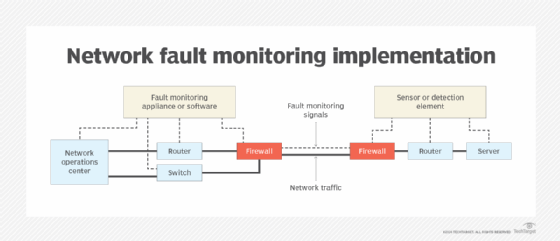
LuckyStep - stock.adobe.com
Use network fault monitoring to prevent malfunctions
Network fault monitoring systems are essential tools to optimize network performance and availability. They are also key components of proactive disaster recovery.
When managing a communications network, no matter how large or small, it is essential to know how well the network is performing. Network fault monitoring enables organizations to detect, recover from and build resilience to network failures in the future.
Fault monitoring is a key resource in a network disaster recovery (DR) plan. When an issue is detected, and if it is determined that the issue is serious, the network DR plan can be activated. Fault monitoring is also a key component of network performance management activities. Network fault monitoring is typically implemented using a centralized system that manages the process of sending, receiving and processing fault messages
Network fault monitoring can help IT teams examine all corners of the network, including the transmission channels, network interface devices, switching systems and network security systems. Fault monitoring systems send out inquiry messages to the network to detect malfunctions, isolate them for analysis and attempt to correct them.
Organizations can implement network fault monitoring in the form of an appliance that connects to the network or through specialized software. The below chart depicts a network fault monitoring implementation.
The goal of network fault monitoring is to ensure that all network elements are functioning normally. Considering how much of an organization's business is transported by its networks, any loss or degradation of network service is a major issue.
Rapid identification, assessment and remediation of a network performance issue are facilitated by fault monitoring technologies.

Active and passive monitoring
Two types of fault monitoring are available: passive and active. Passive monitoring essentially "listens" for fault messages that are sent from various sensors throughout the network. The passive system waits for messages from devices and does not directly interact with network elements.
An active monitoring system sends inquiry messages on a regular basis to network elements equipped with sensors, looking for problems. Issues detected are processed by a centralized system, typically in a network operations center (NOC).
The chart above depicts a fault monitoring configuration that can function either passively or actively. The dotted lines represent the fault detection messages that are sent and received over the network by the fault monitoring system. The system communicates with network devices and systems connected to the network.
In a passive fault monitoring system, the loss of a device with a monitoring sensor will be unable to send alert messages to the NOC. Some devices on the network, such as routers in service provider or cloud networks, might not be detectable. Each device to be monitored will also need to be configured to send messages, which can take additional time. By contrast, an active monitoring system will know if something is wrong by regularly querying devices. Monitoring systems are also easier to set up. In most cases the range of IP addresses to be examined is all that is needed.
Network fault monitoring vs. performance monitoring
Network fault monitoring listens for and captures issues that impact network performance. Network performance monitoring takes this one step further by adding intelligence that analyzes the issues detected and determines how they are affecting network performance. This includes issues such as service availability, throughput and latency.
Performance monitoring systems analyze traffic activities, compare them to preset performance metrics and provide data that organizations can use to make improvements. These systems can send simulated network traffic to various devices and measure how quickly the messages are received and if all data was transmitted and received intact. Results of these tests are presented to network analysts on dashboards that display network maps, devices on the network, traffic on channels in the network and other relevant data.
Advantages and disadvantages of network fault monitoring
One major advantage of network fault monitoring is availability. Plenty of network fault monitoring options exist on the market, including appliances that connect to the network and fault monitoring software applications. In addition to mainstream systems, open-source products can keep costs down and provide sufficient diagnostic capabilities.
Network performance monitoring systems are likely to be a more expensive alternative than fault monitoring systems, since they include capabilities such as AI to provide greater analytical functions. Despite the added cost, users are better able to manage overall network performance with these systems in addition to detecting faults. Network performance monitoring systems can monitor networks continuously, detecting network problems across all points in the network. Network analysts and managers will need to determine the types and granularity of information provided by such devices before making a product selection.
Paul Kirvan is an independent consultant, IT auditor, technical writer, editor and educator. He has more than 25 years of experience in business continuity, disaster recovery, security, enterprise risk management, telecom and IT auditing.






